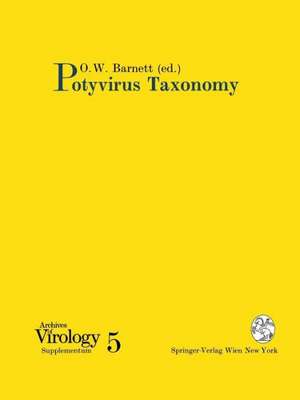Potyvirus Taxonomy: Archives of Virology. Supplementa, cartea 5
Editat de Ortus W. Barnetten Limba Engleză Paperback – 22 sep 1992
Din seria Archives of Virology. Supplementa
-
 Preț: 404.29 lei
Preț: 404.29 lei -
 Preț: 428.56 lei
Preț: 428.56 lei -
 Preț: 391.40 lei
Preț: 391.40 lei - 5%
 Preț: 381.54 lei
Preț: 381.54 lei - 5%
 Preț: 1102.31 lei
Preț: 1102.31 lei - 5%
 Preț: 1313.93 lei
Preț: 1313.93 lei - 18%
 Preț: 961.55 lei
Preț: 961.55 lei - 24%
 Preț: 820.00 lei
Preț: 820.00 lei -
 Preț: 393.52 lei
Preț: 393.52 lei - 5%
 Preț: 1014.10 lei
Preț: 1014.10 lei - 15%
 Preț: 600.26 lei
Preț: 600.26 lei - 18%
 Preț: 1234.94 lei
Preț: 1234.94 lei -
 Preț: 397.76 lei
Preț: 397.76 lei - 5%
 Preț: 384.80 lei
Preț: 384.80 lei -
 Preț: 399.29 lei
Preț: 399.29 lei -
 Preț: 401.24 lei
Preț: 401.24 lei -
 Preț: 401.03 lei
Preț: 401.03 lei -
 Preț: 424.33 lei
Preț: 424.33 lei
Preț: 414.30 lei
Nou
Puncte Express: 621
Preț estimativ în valută:
79.27€ • 82.77$ • 65.61£
79.27€ • 82.77$ • 65.61£
Carte tipărită la comandă
Livrare economică 04-18 aprilie
Preluare comenzi: 021 569.72.76
Specificații
ISBN-13: 9783211823538
ISBN-10: 3211823530
Pagini: 464
Ilustrații: X, 450 p. 22 illus.
Dimensiuni: 210 x 279 x 24 mm
Greutate: 1.03 kg
Ediția:Softcover reprint of the original 1st ed. 1992
Editura: SPRINGER VIENNA
Colecția Springer
Seria Archives of Virology. Supplementa
Locul publicării:Vienna, Austria
ISBN-10: 3211823530
Pagini: 464
Ilustrații: X, 450 p. 22 illus.
Dimensiuni: 210 x 279 x 24 mm
Greutate: 1.03 kg
Ediția:Softcover reprint of the original 1st ed. 1992
Editura: SPRINGER VIENNA
Colecția Springer
Seria Archives of Virology. Supplementa
Locul publicării:Vienna, Austria
Public țintă
ResearchCuprins
Overview of potyviruses and taxonomy.- The general properties of potyviruses.- Application of genome sequence information in potyvirus taxonomy:an overview.- Inclusion bodies.- Potyviruses, chaos or order?.- What is a virus?.- Serology and antigenic relationships.- Serology of potyviruses: current problems and some solutions.- Polyclonal reference antisera may be useful for the differentiation of potyvirus species.- Proteolytic cleavage of the N-terminal region of potyvirus coat protein and its relation to host recovery and vector transmission.- Some unusual serological reactions among potyviruses.- Potyviruses, monoclonal antibodies, and antigenic sites.- Serological relationships involving poty viral non-structural proteins.- Potyvirus serology, sequences and biology.- Coat protein phylogeny and systematics of potyviruses.- Virus biology and variation.- Importance of host ranges and other biological properties for the taxonomy of plant viruses.- Clustering Potyviridae species on the basis of four major traits.- Specific infectivity and host resistance have predicated poty viral and pathotype nomenclature but relate less to taxonomy.- Sources of resistance to viruses in the Potyviridae.- Potential for using transgenic plants as a tool for virus taxonomy.- A potyvirus in nature: indistinct populations.- Potyvirus taxonomy: potyviruses that affect solanaceous crops.- Biological variants of tobacco etch virus that induce morphologically distinct nuclear inclusions.- Biological variability of potyviruses, an example: zucchini yellow mosaic virus.- Designation of potyvirus genera: a question of perspective and timing.- Fungal transmission of a potyvirus: uredospores of Puccinia sorghi transmit maize dwarf mosaic virus.- The usefulness of aphid transmission as a taxonomie criterion for potyviruses.- Genome and sequence relationships.- Viruses of the Potyviridae with non-aphid vectors.- Potyviridae: genus Rymovirus.- How important is genome division as a taxonomie criterion in plant virus classification?.- Sequence data as the major criterion for potyvirus classification.- The recombinative nature of potyviruses: implications for setting up true phylogenetic taxonomy.- Virus relationships.- Nomenclature and relationships of some Brazilian leguminous potyviruses related to bean common mosaic and/or passionfruit woodiness viruses.- Ecology and taxonomy of some European potyviruses.- Relationships among iris severe mosaic virus (ISMV) isolates.- Virus relationships — PVY subgroup.- A comparison of pepper mottle virus with potato virus Y and evidence for their distinction.- Is pepper mottle virus a strain of potato virus Y?.- Evidence that pepper mottle virus and potato virus Y are distinct viruses: analyses of the coat protein and 3? untranslated sequence of a California isolate of pepper mottle virus.- Virus relationships — SCMV subgroup.- A viewpoint on the taxonomy of potyviruses infecting sugarcane, maize, and sorghum.- Differentiation of the four viruses of the sugarcane mosaic virus subgroup based on cytopathology.- Present status of the sugarcane mosaic subgroup of potyviruses.- Virus relationships — BYMV subgroup.- Bean yellow mosaic virus subgroup; search for the group specific sequences in the 3? terminal region of the genome.- Virus relationships — BCMV subgroup.- A proposal for a bean common mosaic subgroup of.- Serological and biological relationships among viruses in the bean common mosaic virus subgroup.- Strains of bean common mosaic virus consist of at least two distinct potyviruses.- Serotype A and B strains ofbean common mosaic virus are two distinct potyviruses.- Summary.- A summary of potyvirus taxonomy and definitions.




